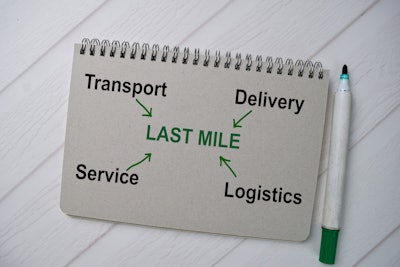
Whether ordering takeout or buying clothes online, door-to-door deliveries have become an everyday essential for people across the world. However, despite how often they feature in our lives, it is only when something goes wrong that we ever really think about them. With the bar constantly being raised higher – due to services like same-day delivery and international shipping being readily available – consumers increasingly expect quick, cheap and reliable experiences every time they shop.
Many organizations know that the ability to produce accurate, consistent, and contextual address data is imperative to a successful last-mile delivery, especially when keeping up with customer demands. This can be achieved through robust data integrity strategies, leveraging geo addressing and data enrichment capabilities to unlock additional context from their data. By harnessing trusted data in this way, organizations can ensure that they are delighting their customers through more seamless purchasing experiences and accurate delivery services.
The Importance of Last-Mile Delivery
The final step of the delivery journey, commonly referred to as last-mile delivery or hyper-local delivery, is the final step in a parcel’s journey – typically occurring when an item gets transferred from a distribution center to its final destination. Although last-mile delivery can differ substantially, such as a delivery from a warehouse compared to a takeout from a restaurant, it has a powerful impact on the levels of perceived customer experience.
In fact, according to research from PwC, 60% of retailers and consumers believe accuracy is the most important factor in successful last-mile delivery, ranking it higher than the likes of speed or convenience. Similarly, 32% of customers would use a different brand after just one bad experience, regardless of previous levels of brand satisfaction. This highlights the jeopardy that a company can find themselves in if their delivery service is inaccurate or not completed in the desired timeframe of the consumer.
It is clear that the ability to produce an error-free last-mile delivery is integral to maintaining happy customers. However, last-mile delivery issues become more frequent when organizations do not implement the correct tools to manage their data.
Data is Key to Successful Last-Mile Delivery
A common cause for challenges in last-mile delivery is when address data is incomplete or of low quality. A typical example would be secondary address information not being stored correctly, i.e. capturing a customer’s apartment number but not knowing which apartment block it’s located in. In this case, the success of the delivery would rely on the driver’s ability to correctly determine the right location, either through guesswork or by directly contacting the customer. Regardless of the driver’s success, there would be elements of uncertainty and inconvenience for everybody involved.
Typically, unsuccessful deliveries occur when organizations aren’t able to correctly manage and operationalize highly valuable address data. Even the smallest of oversights, such as the example provided above, could result in a delivery driver not having an accurate location to leave the package upon arrival. Over time this leads to unsuccessful deliveries, missing parcels and even customer – and driver – attrition.
Address data is fundamental for successful last-mile deliveries and, therefore, its implementation should be as flawless as possible. However, many organizations find that using addresses effectively to fuel decision-making is an extremely complex challenge.
Overcoming the Data Obstacles
Geo addressing and data enrichment solutions are crucial aspects of an organization’s data integrity strategy, especially when it comes to improving trust in address data. Geo addressing combines geocoding – which pinpoints exact locations according to a specific longitude and latitude – with address verification and autocompletion capabilities.
This helps to ensure that addresses are verified, standardized and cleaned for optimum accuracy. Every address is allocated both a hyper-accurate location (or geocode) and a unique and persistent identifier. It also simplifies each address into a simple code, making the data a more reliable dataset and enabling easy enrichment with third-party data.
Features like autocomplete, which suggest full addresses once a customer starts to type them, also vastly help to improve the customer buying experience. Such features are invaluable particularly since it’s estimated that as many as 70% of online shopping carts are left incomplete. As a result, the ability to ensure a more frictionless purchasing experience can become important to help reduce shopping cart abandonment.
In conjunction with address verification, these capabilities help to further ensure a smooth order experience for customers, and that deliveries are successfully delivered to the right place at the right time.
The Importance of Data Context
As previously discussed, enriching datasets is a critical step in helping to ensure that deliveries reach the correct location without any challenges. Data enrichment combines first-party data from internal sources with third-party data from external sources or data from other internal systems. As a result, the accuracy of an organization’s data can be greatly improved, while also helping to reveal invaluable insights about assets, customers and potential risks.
Data enrichment greatly helps to improve the success of last-mile deliveries. The ability to access more specialized information surrounding a location, such as whether it is a gated community or not, can be crucial in helping a driver to accurately locate the intended destination – reducing the possibility of an unsuccessful delivery.
The Solution to Last-Mile Delivery Success
The success of last-mile delivery depends on the accuracy, consistency, and context of the data behind it. A robust data integrity strategy, including geo addressing and data enrichment, allows organizations to successfully operationalize their address data and ensure more frictionless customer experiences – all the way through the buying process to the very last step in delivery.
In an era when even a single mistake can significantly impact customer loyalty, ensuring the accuracy of address data, simplifying data enrichment processes and, ultimately, unlocking crucial context from data is imperative for organizations seeking to stay competitive and win the last-mile delivery race.














![Pros To Know 2026 [color]](https://img.sdcexec.com/mindful/acbm/workspaces/default/uploads/2025/08/prostoknow-2026-color.mduFvhpgMk.png?ar=16%3A9&auto=format%2Ccompress&bg=fff&fill-color=fff&fit=fill&h=135&q=70&w=240)





